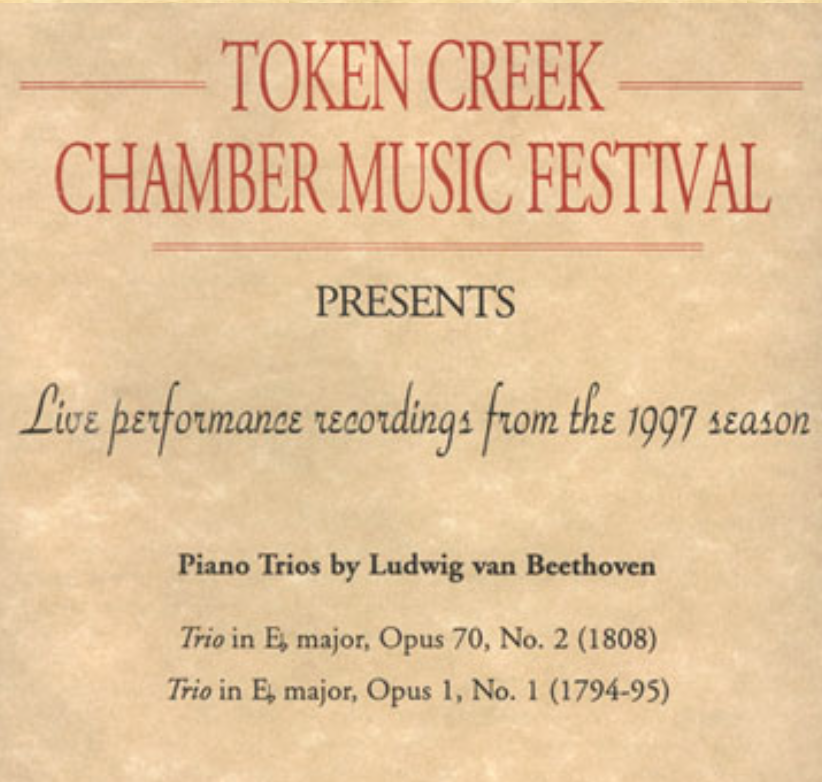TCF 2020 Virtual Season · Music from the Barn
Celebrating Beethoven
with Robert Levin, piano
Program
Sonata in G major for Violin and Piano, Op. 96 “Cockcrow” (1812) Ludwig van Beethoven (1770-1827) I. Allegro moderato II. Adagio espressivo (attacca) III. Scherzo. Allegro IV. Poco allegretto- Rose Mary Harbison, violin
- Robert Levin, piano
- from the 2010 Token Creek Festival
- Rose Mary Harbison, violin
- Rhonda Rider, 'cello
- Robert Levin, piano
- from the 1997 Token Creek Festival
re-discovered and reconstructed from original sources by Hans-Werner Küthen, 1995) I. Allegro moderato II. Andante con moto III. Rondo. Vivace
- Robert Levin, piano
- Rose Mary Harbison & Laura Burns, violin
- Jennifer Paulson & Andrew Waid, viola
- Parry Karp, 'cello
- from the 2010 Token Creek Festival
Program Notes
On the occasion of his 250th anniversary Beethoven is being celebrated worldwide this year. But we didn’t need an excuse — at Token Creek Beethoven has, from the start, been a mainstay of our programming. But for this concert we’re especially pleased to offer an all-Beethoven program with one of our favorite colleagues — beloved worldwide for his scholarship, for his command of, especially, music of the classical period, and for his stunning period improvisations: the formidable pianist Robert Levin. Levin has appeared at Token Creek in every role imaginable: concerto soloist, chamber music collaborator, recitalist, Mozart completionist, improvisor, and scholar. We’ve been happy he could join us on so many different occasions and in so many different seasons.
Performances here of the opening and closing works on this program, the Op. 96 violin sonata and the G major concerto, derive from an all-Beethoven program that opened our 2010 Token Creek season.
The Op. 96 is Beethoven’s tenth and final violin sonata, written in 1812, after a ten-year gap following his prior effort in the medium. It, along with his “Archduke” Trio, Op. 97 also composed that same year, is dedicated to his patron (and also student) the Archduke Rudolf, who played the piano part at the premiere. The sonata stands out in Beethoven’s oeuvre, marked overall by an intimacy, restraint and geniality. But some of those evident qualities mislead. The piece requires unusually quick reactions from both performers and listeners, is seldom truly expansive, even the smallest motives are asked to be heard melodically. Some players have found this sonata too exacting, too constantly specific. It seldom has time to simply enjoy itself. This reaction is reinforced in the final movement, variations which harp upon an eccentric tonal relationship midway through the theme. This trait occasions increasingly intricate episodes as the movement progresses, which are further drawn out and celebrated toward the end. The “innocence” with which the theme begins is misleading.
The Opus 70/2 piano trio (from our 1997 season) is Beethoven’s summa in a genre that he began exploring very early in his career. This piece is consistently inventive, original, and memorable, at the highest level of this composer’s achievement. From the thoughtful introduction, which turns out not to be introduction, but a subtle and original early appearance of one of the crucial thematic ingredients of the first movement, through to the most passionately animated of this composer’s final movements, this piece sustains invention and generosity of an incomparable kind. The middle movements are both described as Allegretto: the first a beautiful reimagination of Haydn’s double variation type, the next a dance magically reimagining Schubert, and equally unusual. (The other trio of Opus 70, fine and indestructible, is less democratic in its instrumental conversation, and much more conventional and public in its address.)
Token Creek has a long history of presenting concertos in chamber versions—one player per part, in a manner offered by Mozart for many of his pieces, and also often adapted by ourselves. This quintet version of the G major concerto is Beethoven’s own, prepared the year following its composition, noteworthy for the unusual sound achieved by the addition to a standard string quartet of a second viola. The version disappeared, and was not discovered until 1995 when Hans-Werner Küthen reconstructed it from Beethoven’s sketches. Not just a transcription, this version contains Beethoven’s (?) substantial alterations for the piano solo especially in the music of the first movement.
We’ve presented this concerto twice at Token Creek, both times with Robert Levin, the second time perhaps unadvisedly adding contrabass. We choose to present the first version, partly to allow our listeners to experience with us the tight rope suspense of one of Levin’s improvised cadenzas as it defies gravity, safety, and comfort. Many patrons gratefully remembered the performance, and especially the cadenza, many months—even years—later.
Available on CD
TCR 001 Piano Trios of Ludwig von Beethoven
features Beethoven’s Piano Trio in E-flat major, Op. 70, No. 2 from today’s program.

This unique, limited-edition recording of live performances from our 1997 season is available for purchase from our online store while supplies last.
Click here to order.